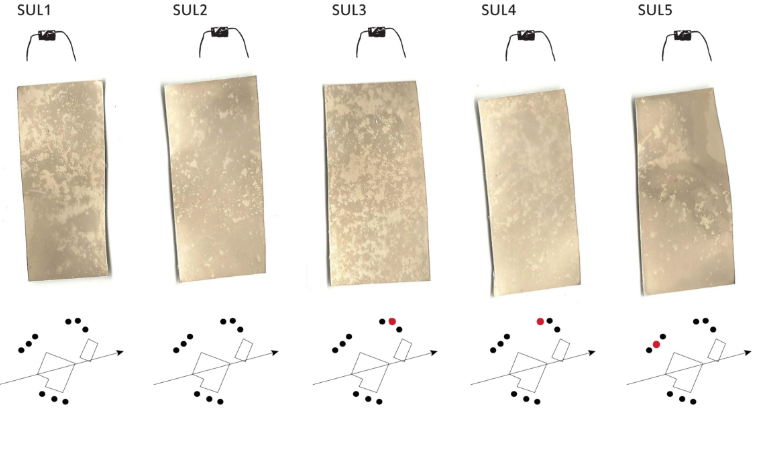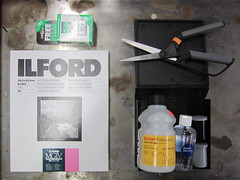
Hydrogen Sulfide Photopaper
Silver halide photo paper tarnishes in the presence of hydrogen sulfide, creating silver sulfide. In this method, we expose photo paper to air and assess the relative amount of airborne hydrogen sulfide present. We hope to make this a quantitative method soon.
Basic info
The silver halide in photographic paper tarnishes when exposed to H2S. The paper changes color inside the canisters depending on the level of H2S it has been exposed to, with darker strips indicating higher levels of exposure. This method is low-cost, easy to assemble using everyday materials, and may be more accessible to non-programmers.
We are still working on determining the detection limit of the method (i.e. the lowest concentration of hydrogen sulfide that would visibly discolor the photo paper), and the relationship between the concentration of hydrogen sulfide and the extent of visible tarnish. We also are interested in determining the influence of other corrosive gasses, such as sulfur dioxide, on the photo paper as well. Eventually we are hoping this can be a quantitative, or even semi-quantitative method for measuring atmospheric hydrogen sulfide.
Purpose
Hydrogen sulfide, which is a well documented but little understood health hazard, is one of the leading causes of injury in the workplace. Health issues have been clearly linked to H2S, and since 2011 the EPA has required the oil and gas to report their emissions to the Toxics Release Inventory (TRI). Despite this, much hydrogen sulfide still gets into the air with little regulation (Fracking Boom Spews Toxic Air Emissions on Texas Residents). Public Lab researchers are attempting to innovate novel, low-cost community based approaches to environmental health problems like hydrogen sulfide, so that communities and workers may begin not only developing systems to track their exposure, but also generating data and evidence in order to scientifically validate their experiences.
The photopaper sensing tool is being developed to detect hydrogen sulfide in an affordable, quantifiable manner. In September of 2011, Public Laboratory members met with residents of Garfield County, Colorado to discuss the growing hydrogen sulfide problem in their small, rural community. The community had recently organized to take a gaseous grab sample from one resident’s kitchen sink. Analysis of the grab sample showed hydrogen sulfide levels of more than 185 times above the long-term exposure level recommended by the EPA (Gassed by Global Community Monitoring). The family, in which the son developed painful skin lesions and other symptoms coincident with this exposure, was forced to abandon the house. They are seeking legal assistance, but so far, neighboring gas development companies have denied association with the families water contamination. The grab sample, while able to capture one record of exposure, was costly (over $500) and had to be shipped to a lab in California within 24 hours in order to ensure the samples viability. The family did not hear results of the test for weeks, all the while continuing their exposure.
Method Limitations
The current primary limitation of this method is the unknown relationship between hydrogen sulfide concentration and the extent of visible tarnish on the photo paper. Related to this outstanding question, we'll need to determine how different environmental conditions affect that relationship (e.g. how does high relative humidity influence the extent of tarnish at a given hydrogen sulfide concentration?), and the influence of other corrosive gasses (e.g. sulfur dioxide).
This method requires that small canisters with prepared photo paper in them be deployed for multiple weeks in order to discolor appreciably. That could be considered a limitation, depending on what your sampling restrictions are. The long time-integration will also make it challenging to compare the concentration of hydrogen sulfide ultimately estimated based on the exposed photo paper, and any health and environmental standards for hydrogen sulfide, which are generally written for 8-hour or 24-hour time periods.
Literature review
This project is based on these two papers by geologist C. J. Horwell and colleagues that used photographic paper to measure hydrogen sulfide concentrations near volcanos in New Zealand.
Horwell, C.J., Allen, A.G., Mather, T.A., Patterson, J.E., 2004. Evaluation of a simple passive sampling technique for monitoring volcanogenic hydrogen sulphide. J. Environ. Monitor. 6, 630 - 635. Horwell_JEM_2004_copy.pdf
Horwell, C.J., Patterson, J.E., Gamble, J.A., Allen, A.G., 2005. Monitoring and mapping of hydrogen sulphide emissions across an active geothermal field: Rotorua, New Zealand. J. Volcanol. Geotherm. Res. 139, 259-269. Horwell_JVGR_2005_copy.pdf
Original photopaper map made by Horwell et al.
Online Bibliography
https://www.zotero.org/groups/275050
Design Philosophy
This method has been developed in order to produce a hydrogen sulfide detection method that is:
inexpensive
easy to set up and use
easy to interpret results
does not require human presence for the entire exposure period
consistent and reliable
Discussions and Development Spaces
Conversations about this method happen in research note comments (see tag:h2s-photo-paper) and on plots-airquality@googlegroups.com. This project is largely being spearheaded by folks at Northeastern University in Sara Wylie's research group: Sara Wylie, Elisabeth Wilder, Deb Thomas, Cait Kennedy, Megan McLaughlin, and Hannah Gartner, and more!
Feel free to contact any of the people listed above if you are interested in getting more involved. You can also try following the prototype documentation to make your own film testing strips, and be sure to share any new tests sites or uses for this tool.
This project is partially funded by a grant from the American Anthropology Association, Anthropology and Environment section
About the data
This method produces visual data. In order to present and communicate this data, taking pictures of the exposed photo paper is essential. Ultimately we hope to quantify the extent of discoloration of photo paper (perhaps using an app similar to that being developed for the SmART-Form project.
It has been demonstrated, by Horwell et al and by research posted here in Public Lab, that the extent of brown tarnish of the silver halide photo paper is more extreme under conditions with higher hydrogen sulfide concentrations. However, we have work to do in order to try to quantify this relationship. We also need to get more hands trying this method in comparison to other commercial methods, such as Draeger tubes or Jerome meters, to evaluate the relationship between this and other method measurements.
Obtaining this tool
Canisters in the process of being set up
Instructions for how to build your own photo paper canisters are included here: H2SphotopaperHowTo_ew__(1).pdf
We plan to get prototype kits in the store soon too!
Activities
| Purpose | Category | Status | Author | Time | Difficulty | Replications |
|---|---|---|---|---|---|---|
| Nothing yet on the topic "h2s-photo-paper" -- be the first to post something! |
Activities should include a materials list, costs and a step-by-step guide to construction with photos. Learn what makes a good activity here.
Research Notes
| Title | Author | Updated | Likes | Comments |
|---|---|---|---|---|
| Nothing yet on the topic "h2s-photo-paper" -- be the first to post something! |
Please see the bottom of this wiki for an additional list of research notes for this project.
Questions
| Title | Author | Updated | Likes | Comments |
|---|---|---|---|---|
| Nothing yet on the topic "h2s-photo-paper" -- be the first to post something! |
Additional Resources
Project Research Notes
Information on H2S and detection
Hydrogen Sulfide Monitoring in Gas Patch: Background
Hydrogen Sulfide: Information on the Gas
Conversion from µg/m3 to ppm hydrogen sulfide
Hydrogen Sulfide Testing with Black and White Film
Hydrogen Sulfide Tarnishing Silver
Controlled Testing with B&W Film Hydrogen Sulfide Detectors
Field Test Sites
Aztec, New Mexico
Map of area to be tested in Aztec, NM
Choosing Test Sites in Aztec, NM
Identifying Wells in Field and Experiment Design
Collection and Processing of Aztec Test Strips
Analyzed Results and Suggested New Steps for H2S Testing in Aztec, New Mexico
New Experimental Design, Aztec, New Mexico
New Container Tests, Aztec, New Mexico
Designs for Next Round of Experiments, Aztec, New Mexico
Powder River Basin, Wyoming
Results of three rounds of testing in Deaver, WY
Photopaper Sensing Tool - Development Notes, Deaver, WY
Wyoming Hydrogen Sulfide Testing 2013-2014
Poweshiek County, Iowa
Sensing Hydrogen Sulfide from CAFO Emissions in Poweshiek County, Iowa
How to Guide:
Download a copy: H2SphotopaperHowTo_ew__(1).pdf




